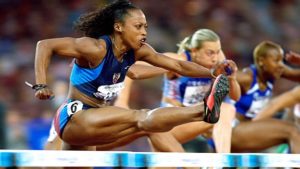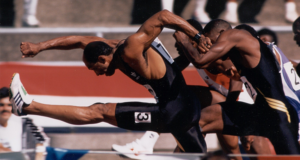Getting too Close: Advice for the Elite Hurdler
by Steve McGill
For elite hurdlers — those in the 13.5 range or faster for males, or more like the 13.0 range and faster for females, the margin for error in a race shrinks dramatically in comparison to hurdlers who aren’t at that level. Negotiating the space between the hurdles becomes more and more difficult and the danger of running out of room and crashing becomes more and more real. In this article, I would like to discuss ways that athletes at this level can improve their ability to negotiate the space between the barriers without sacrificing aggression.
For elite hurdlers, technical flaws are magnified. A minor technical flaw can be disastrous, depending on circumstances. Flaws like clearing the hurdles a smidge too high, straightening the lead leg too soon, delaying the trail leg too long, allowing the trail arm to swing too far back, swinging the lead arm across the body, can have major consequences. So, the first way to improve one’s ability to negotiate the space is to clean up all technical flaws so that one can be super-efficient with hurdle clearance.
[am4show not_have=’g5;’]
[/am4show][am4guest]
[/am4guest][am4show have=’g5;’]
Throughout the history of the event, there have been plenty of hurdlers who habitually straightened their lead leg too soon. Sometimes they got away with it and ran great races; sometimes they hit some hurdles, which slowed them down and cost them victories; sometimes, they ended up in the ground. This was more of a back in the day problem, as almost all elite hurdlers today lead with the knee as opposed to swinging from the hip. Back in the day hurdlers who did straighten the lead leg, off the top of my head, would include Greg Foster, Gail Devers, and Tony Dees, all of whom rank among the greatest hurdlers who ever lived. In Foster’s case, in his battles against Renaldo Nehemiah and others, his lead leg kicking out often caused him major space issues, forcing him to run up on hurdles and stop, especially when Nehemiah got out early on him and forced him to race from behind. In Devers’ case, there was the classic example of the dangers of leading with a straight leg when, at the 1992 Olympics, on her way to a gold medal, she smacked the last hurdle with the foot of her lead leg, stumbled, and was passed by a whole bunch of women and ended up out of the medals. For Dees, there weren’t ever any major incidents, but there can be no doubt that with his athletic abilities and raw speed, he would’ve been a sub-13 guy had he learned to lead with the knee. Duane Ross, who ran in the 13.20 range in the late 1990’s, in another one who comes to mind who could’ve surely run faster if not for that straight-leg lead.

Devers’ straight-leg lead
When it comes to arm action, the arms must transition quickly. If either arm hangs in the air too long, the other arm will hang in the air too long, and both legs will hang in the air too long. The lead arm is the key to the whole operation. When you look at hurdlers like Allen Johnson, Liu Xiang, Sally Pearson, Orlando Ortega, and Keni Harrison, to name a few, you’re looking at hurdlers who have a very tight, precise arm action with both arms. The lead arm only goes as high as it has to, and it stays in either an up-and-down motion or a cyclical motion, enabling the legs to keep cycling so that the lead leg cycles back to the ground immediately after the heel passes the crossbar. The hand of the trail arm, meanwhile, hugs the hip during the dive into the hurdle, and punches back up during descent. There are two hurdlers who come to mind whose arm action is/was less efficient, and who have suffered consequences: Lolo Jones on the women’s side and Omar McLeod on the men’s side. Jones, like Devers, hit a late hurdle and cost herself a gold medal, this time at the 2008 Olympics. In her case, her arms were the culprit. Elite hurdlers have to maintain very low, lightning-quick arm carriage. Jones ran with relatively high arm carriage, which slowed the transition from up to down (lead arm) and down to up (trail arm), keeping her in the air longer, and causing her to land further out than what would’ve been optimal. In that race, it caused her to hit a hurdle, stumble, and she couldn’t recover. In regards to McLeod, you may have noticed that he had become a hit or miss guy. When he’s on, he’s dominant; when he’s not, he’s all over the place, hitting hurdles, swerving into other people’s lanes. Omar’s lead arm tends to swing across his body, and sometimes it’s pretty severe. When he does so, he lead leg straightens out and locks at the knee. Personally, I think he needs to get his hips taller, especially since he’s smaller. He’s someone whom I definitely feel would benefit from getting more of a push off the back leg at take-off.

Greg Foster was another hurdler whose straight-leg lead caused him problems.
The thing is, even with exquisitely efficient technique, there will still be the danger of getting too close, of running out of room to clear the next hurdle. That’s why I always say that hurdling is the only event in track and field, and perhaps in all of sports, where getting better creates more problems. The hurdles keep coming at you. So, in addition to constantly drilling to keep the technique sharp and to address any technical flaws, elite hurdlers need to always be doing rhythm drills in order to quicken their cadence and to enhance their ability to adapt to circumstances. You never know when you’re gonna catch a tailwind that will put you even closer to hurdles than usual. You never know when the hurdler in the next lane will bump you off balance for an instant. So you have to be ready for everything.
The lane-line drill, shown in the video below, is one that I implement to ingrain the habit of low/quick hands and low/quick feet between the hurdles. Moving across the track, the athlete has to fit in three super-quick steps between each lane line, making a slight jump over the line to mimic the action of clearing a hurdle.
Beyond that, the usual drills that are part of my routine would come next — the cycle drill and the quickstep drill, but both with an exaggerated emphasis on quickness. The usual spacing for the quickstep drill, for example, is 21 feet for females and 24 feet for males. If my goal is to quicken the cadence in races, I’ll decrease the spacing to 18-20 feet for females and 21-23 feet for males. And we’ll do this over 8-10 hurdles so that fatigue becomes a factor and staying focused and relaxed becomes more difficult.
And unlike usual, we’ll time the drills. We’ll time everything. I think that’s very important for elite hurdlers — timing the reps can tempt the hurdler to lose focus on what they’re doing and lead to focusing too much on the time. You can want to create that distraction. And you also want to create that challenge. If they’re improving their times in the drills, that’s an indication that they have a good chance of improving their times in a race.
Finally, there’s the jamming workout that Jean Poquette used when coaching Renaldo Nehemiah, and that Coach Cotto and I use quite often as well. Have the hurdler do block starts with all hurdles after the first hurdle moved in very close — close enough to mimic the severity of crowdedness that he or she is feeling in races. Don’t be afraid to move them in as much as three feet. This workout will teach them to embrace the danger, and it will force them to be quicker than what feels comfortable. And that will carry over into races. Then once the athlete grows comfortable with that rhythm, you keep increasing the challenge by continually decreasing the spacing as the season goes on to avoid stagnation.
[/am4show]
